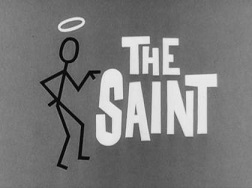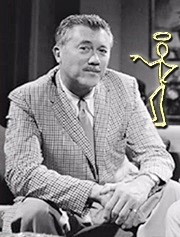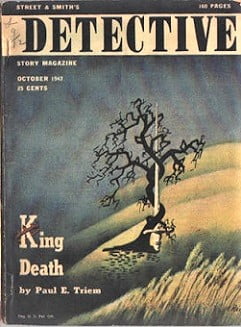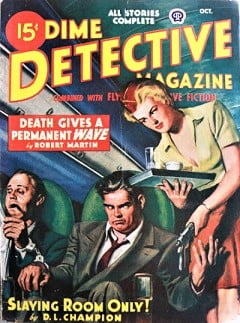
 The Saint (1945, 1947-51) aired “Greed Causes Murder” on October 29, 1947 as its 43rd episode. We have run only four previous episodes of this fine show, the last being in March of 2018, just over a year and a half ago. For new listeners I now borrow freely from that show’s opening remarks as they deal with the creator and partial history of The Saint on radio, in print, and on film. It is estimated there were in the neighborhood of 157 unique episodes (depending on which historian you talk to) of which approximately 57 are in circulation.
The Saint (1945, 1947-51) aired “Greed Causes Murder” on October 29, 1947 as its 43rd episode. We have run only four previous episodes of this fine show, the last being in March of 2018, just over a year and a half ago. For new listeners I now borrow freely from that show’s opening remarks as they deal with the creator and partial history of The Saint on radio, in print, and on film. It is estimated there were in the neighborhood of 157 unique episodes (depending on which historian you talk to) of which approximately 57 are in circulation.
Crime and mystery novelist Leslie Charteris’ (photo at right, 1907-1993) famous detective Simon Templar was dubbed The Saint by the underworld, though he was hardly what the monicker implied. The story goes that he came by the name because of his initials, S. T.. The Saint, as a radio show (there were movies, tv shows, novels, and even comic books), ran first in 1945, and then from 1947-1951, with almost all episodes featuring the incomparable Vincent Price (photo lower right, 1911-1993).
The first Saint novel was published in 1928 when Charteris was just shy of his 21st birthday and was titled Meet the Tiger. In later years Charteris practically disowned the novel, remarking that it was so poorly written he wondered how it ever got published. Instead, he preferred to count 1930’s second Saint novel Enter the Saint as the first true Saint novel. Be that as it may, he would write Simon Templar adventures (novels, short stories, and novellas) off and on for the next 33 years, the final Saint book written solely by himself being a collection of  stories in 1963 titled The Saint in the Sun. Thereafter, all of the Saint titles would be ghost-written but credited to Charteris, who remained in an editorial capacity, reading the manuscripts and editng where necessary. Of interest to science fiction readers is that the first of the ghost-written Saint novels was written by none other than Harry Harrison (1925-2012, SFWA Grand Master 2009, photo at left), and was 1964’s Vendetta for the Saint. Harrison, also an illustrator early in his career (the legendary Wally Wood would ink Harrison’s pencils for several SF comics, among them Weird Fantasy and Weird Science), also wrote the syndicated The Saint comic strip.
stories in 1963 titled The Saint in the Sun. Thereafter, all of the Saint titles would be ghost-written but credited to Charteris, who remained in an editorial capacity, reading the manuscripts and editng where necessary. Of interest to science fiction readers is that the first of the ghost-written Saint novels was written by none other than Harry Harrison (1925-2012, SFWA Grand Master 2009, photo at left), and was 1964’s Vendetta for the Saint. Harrison, also an illustrator early in his career (the legendary Wally Wood would ink Harrison’s pencils for several SF comics, among them Weird Fantasy and Weird Science), also wrote the syndicated The Saint comic strip.
 Simon Templar falls into the camp of the “soft-boiled” detective, in line with such as Nero Wolfe, Sherlock Holmes, and Dashiell Hammett’s Nick Charles (who prefer solving crimes with their wits rather than their fists), as opposed to the “hard-boiled” branch of the detective tree and the likes of Sam Spade, Phillip Marlowe, and Boston Blackie. The iconic stick figure with halo representing the Saint was first introduced in the early stories as a calling card Templar would leave so that his enemies would know who was responsible for their downfall. The titlecard/logo at top left was used in the 1960’s The Saint tv series starring future James Bond star Roger Moore. The series originated in the UK and ran from 1962-69, but was picked up by NBC in America and ran as a summer replacement in 1966.
Simon Templar falls into the camp of the “soft-boiled” detective, in line with such as Nero Wolfe, Sherlock Holmes, and Dashiell Hammett’s Nick Charles (who prefer solving crimes with their wits rather than their fists), as opposed to the “hard-boiled” branch of the detective tree and the likes of Sam Spade, Phillip Marlowe, and Boston Blackie. The iconic stick figure with halo representing the Saint was first introduced in the early stories as a calling card Templar would leave so that his enemies would know who was responsible for their downfall. The titlecard/logo at top left was used in the 1960’s The Saint tv series starring future James Bond star Roger Moore. The series originated in the UK and ran from 1962-69, but was picked up by NBC in America and ran as a summer replacement in 1966.
On American radio, however, Vincent Price was the undisputed, one and only Simon Templar, the Saint. His velvety voice and witty banter engendered the proto-typical suave, bon vivant hero/detective, though in a number of episodes the sexual innuendos written for not only his lines, but those of other characters were a bit too risque and obvious for the perceived audience in the late 1940s, though The Saint‘s legion of fans didn’t seem to care.
This episode turns on the puzzle of why a petty crook seeks to steal a decrepit jalopy from an old man when a more valuable vehicle would be more to his financial advantage when fenced for resale. Several corpses provide grim testimony that the price of involvement in shady doings is high as Vincent Price is witness to the fact that “Greed Causes Murder.”
Play Time: 24:18
{Two days before Halloween of 1947 found the neighborhood ghouls and goblins at their home away from home, the corner newsstand in search of dark deeds in some of their favorite detective pulps. Street & Smith’s Detective Story Magazine (1915-53) was one of the first, most stable and long-running of all detective magazines. In 1947 it was a monthly. Dime Deective Magazine (1931-53) proved another reliable magazine which attracted, from time to time, some of the most popular talent in the field. It too was a monthly in 1947. New Detective (1941-55), a relative newcomer in the field, sought to publish new, exciting fare but the contents ran to mostly police detective stories whch still managed to attract enough of an audience to manage a decent run of 14 years. It was a bi-monthly in 1947. Fast-paced, no holds barred, page-turning crime fiction was the order of the day for all three magazines.]
[Left: Detective Story Magazine, Oct. 1947 – Center: Dime Detective, Oct. 1947 – Right: New Detective, Nov. 1947)



To view the entire list of weekly Old Time Radio episodes at Tangent Online, click here.